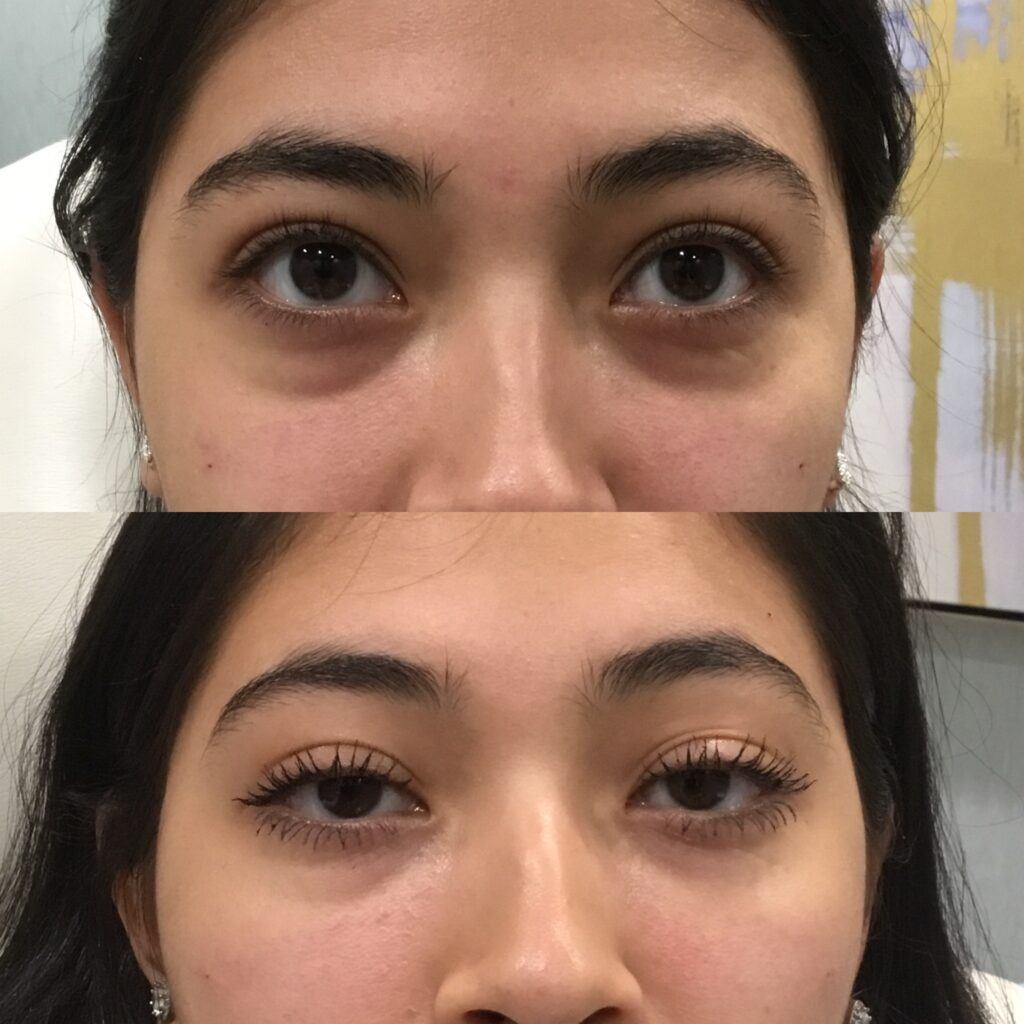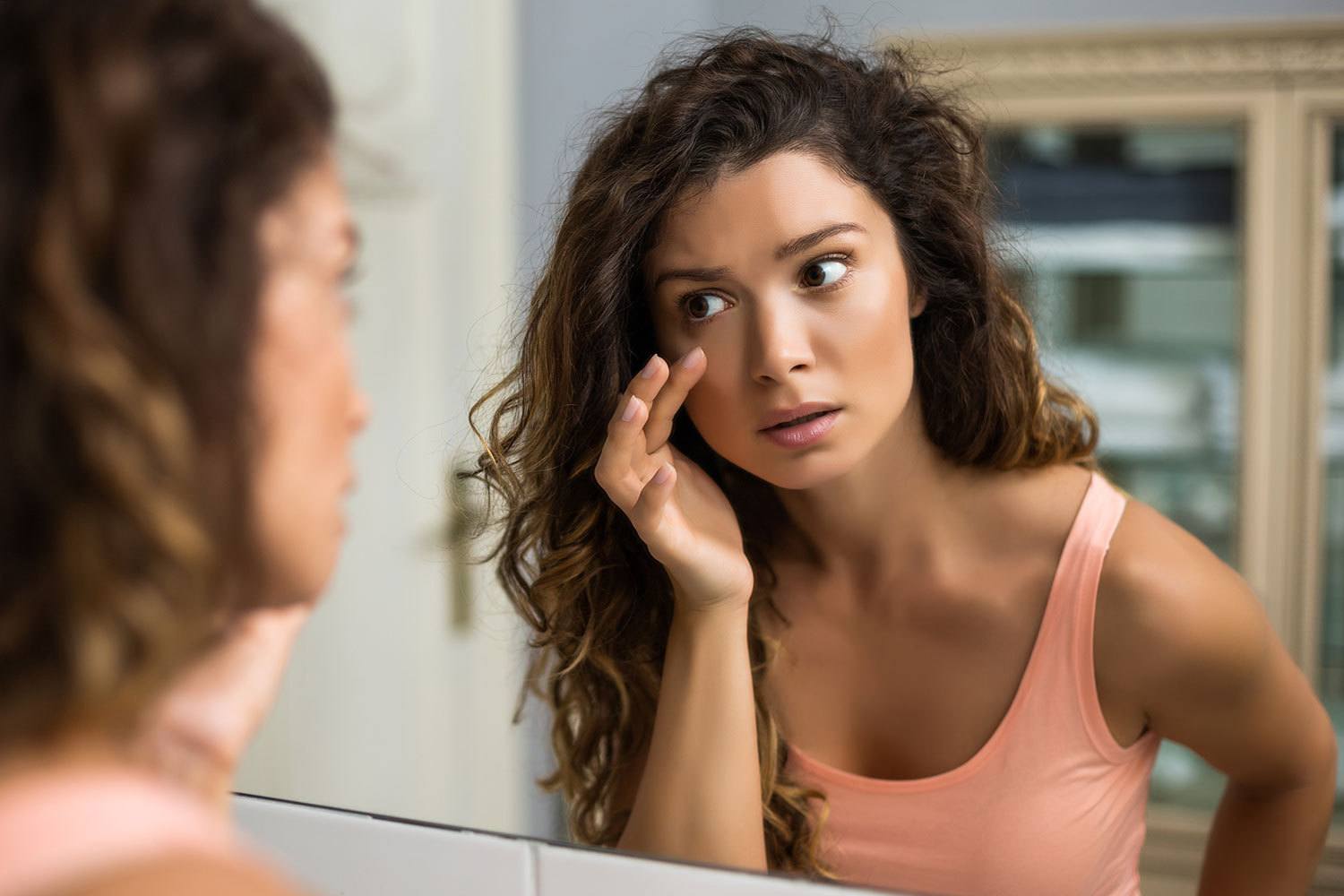You may have heard about TikTok’s surprising new 2021 makeup trend: painting on dark under-eye bags. While we’re all for creative makeup ideas as well as embracing our quirks, the truth is that under-eye bags can be a sign of fatigue and age-induced volume loss, and they often make people feel self-conscious. For these reasons and more, we spoke with our board-certified plastic surgeon, Dr. Basu, about the reasons we get under-eye bags and how to treat them.
Why do we get under-eye bags?
According to Dr. Basu, under-eye bags can be caused by a variety of environmental and biological reasons, including:
Lack of sleep.
This is the most common reason people develop dark, puffy circles under their eyes. When you don’t get enough sleep, the blood vessels in your body dilate, causing an increase in blood flow. Since the skin around your eyes is thinner, this blood flow can cause the under-eye skin to darken. Lack of sleep can also cause fluid to build up beneath your eyes, making them look puffy and even swollen.
Allergies.
When the area underneath your eyes takes on a reddish or purplish color due to allergies or other sinus issues, this discoloration is known as “allergic shiners.” These puffy eye pockets or dark circles can be uncomfortable and embarrassing, and may even be itchy and watery if your allergies are severe.
Hyperpigmentation.
Some people of color naturally have a darker complexion around their eyes, making the area more prone to hyperpigmentation. Naturally deeper tear troughs and thinner lower eyelid skin compound the issue. Prolonged time spent in the sun without proper sunscreen and UV-blocking sunglasses can cause hyperpigmentation under the eyes to worsen.
Aging.
Aging leads to skin volume and subcutaneous fat loss, which can cause dark circles to appear more prominent and skin to sag around the eyes.
Genetics.
Some people naturally have larger fat deposits below their eyes, causing their under-eye area to be more prominent. These fat deposits often worsen in appearance as you age, due to thinning skin and hollowing of the upper cheekbones. Predisposition to thyroid disorders may also play a problem, as an overactive thyroid can cause the eyes to swell—a condition known as thyroid eye disease (a.k.a. Grave’s eyelid disease).
Eye strain.
From work to video chats to relaxing with some Netflix at the end of the day, many of us are spending a significant portion of our day staring at screens. This can place extra strain on the eyes, causing the blood vessels around them to enlarge and the skin to darken, similar to when we don’t get enough sleep.
How do I get rid of under-eye bags?
1. Improve sleep habits.
One of the most basic and effective ways to reduce the appearance of under-eye bags is to get a good night’s sleep. Avoid drinking or eating at least 2 hours before bedtime and avoid looking at your phone during this time. Also, consider using your bed solely for sleeping, as this will help condition your body to associate it with sleeping. Regular exercise throughout the week can also help you fall and stay asleep, but make sure it’s not in the hours before bed. If these suggestions aren’t working, check in with your doctor about recommended steps.
2. Investigate allergens.
The most effective and long-term solution to reducing the appearance of allergic shiners is to eliminate any allergen(s) from your environment and/or diet. You can do this either through allergy testing at an allergist’s office or by trying an elimination diet. The good news is that allergic shiners should disappear once the allergens are removed and your nasal congestion is relieved. Some easy at-home ways to improve the appearance of allergic shiners include placing a cold compress under your eyes, propping your head up at night when you sleep, and using a Neti pot to rinse out your sinuses.
3. Exercise and diet.
Exercising regularly and drinking plenty of water can reduce the appearance of under-eye bags by increasing blood flow away from your eyes and removing any toxins that may be present. Drinking water also hydrates your cells, reducing water retention that causes puffiness in your orbital area. Avoid a high-salt diet, as sodium dehydrates the body.
4. Tear trough fillers.
While fillers won’t treat the underlying causes of your dark circles, they deliver impressive and quick results that can last for over a year. There are two ways injectable cosmetic fillers can be used to improve the appearance of the under-eye area, both of which work by “leveling out” the skin:
- If you have dark circles without fat deposits, a layer of filler can help disguise them by filling in the shadowed hollows (a.k.a. tear troughs). There is one caveat: if the discoloration around your eyes is caused by hyperpigmentation in the skin, you should explore other treatment options.
- If you have fat deposits, fillers can volumize the area around your bags to smooth the transition from your cheeks to your eyes.
If you choose to receive dermal fillers under your eyes, it’s important that you choose a board-certified plastic surgeon, as injecting around the eyes requires great surgical skill.

Before and After fillers for dark undereye circles.
5. An eyelid lift.
If you’re looking to permanently improve the appearance of under-eye bags, an eyelid lift, a.ka. “blepharoplasty,” can remove excess skin and fat under the eyes to reduce puffiness and wrinkles. If you also are seeing drooping of the upper eyelids, upper blepharoplasty can address this issue, invigorating your appearance and improving your field of vision. For those who want a more “open” appearance to the eyes, double fold eyelid surgery can reshape the eye opening. Whatever option you choose, recovery is usually a breeze: thanks to their thin skin, eyelids are one of the areas of the body that heals the fastest.
6. Laser skin resurfacing.
Though laser skin resurfacing can’t actually reduce under-eye bags, it can improve wrinkles and sun damage on the skin overlying the fat, making your eyes appear more refreshed and youthful. Laser skin rejuvenation can also be used to complement a blepharoplasty procedure by improving the skin’s complexion and further tightening the skin after the fat bags are removed.
Laser skin resurfacing can be performed at the same time as your blepharoplasty if your surgeon’s incisions are on the inside of your eyelids; if incisions must be made on the exterior of the eyelids, your surgeon will ask you to wait for the skin to heal before having laser resurfacing done.
Trust your eye results to a board-certified plastic surgeon
The eyes are the most visible and expressive part of the body, and great eye surgery results come from working with a qualified and experienced plastic surgeon. Board-certified plastic surgeon Dr. Bob Basu has years of experience performing eye procedures. If you’re considering aesthetic surgery to improve the appearance of your eyes in the Houston area, trust Dr. Basu for your procedure. Contact him online or call (713) 799-2278 to schedule a consultation today.

Leave a Reply